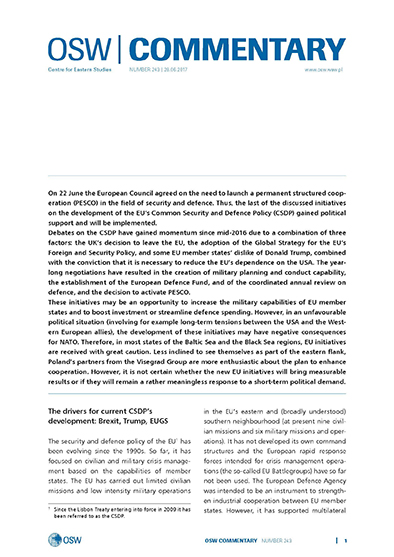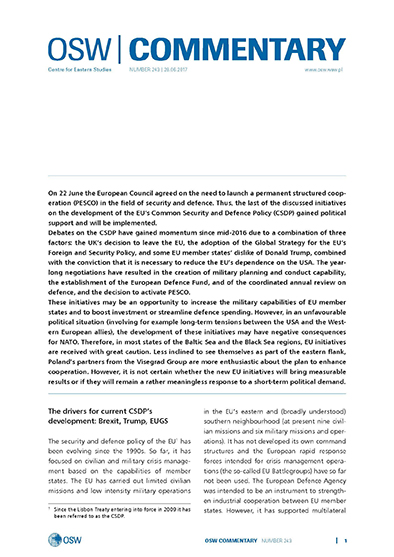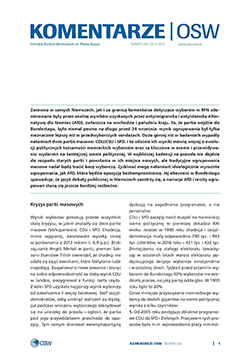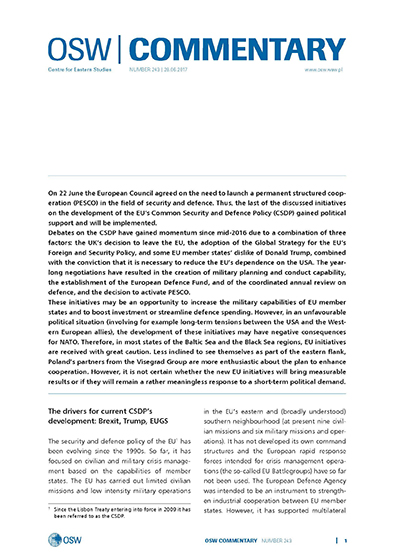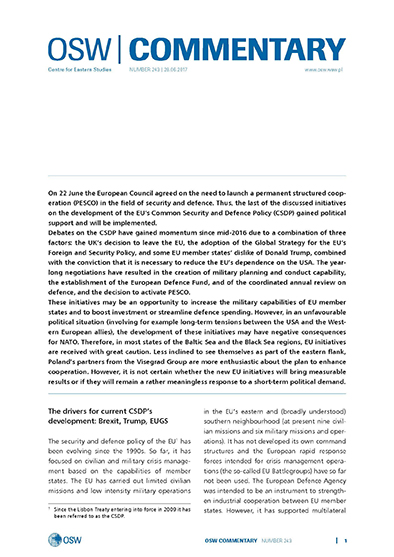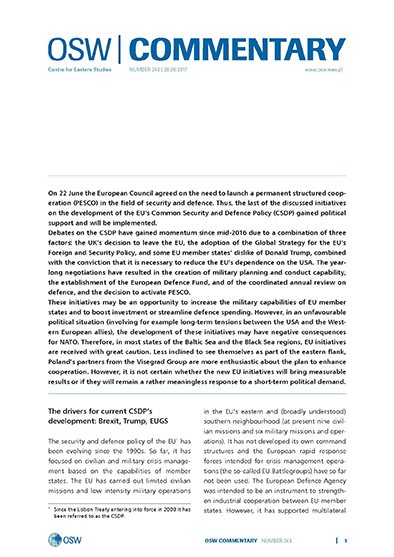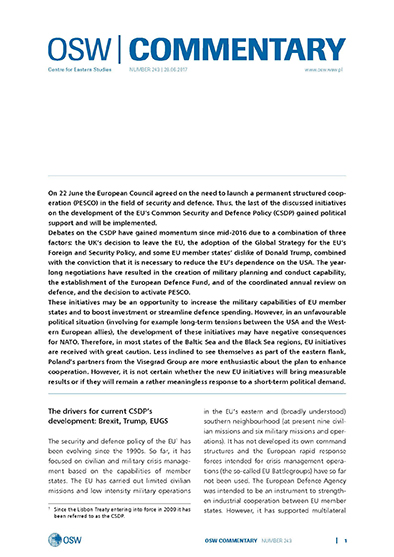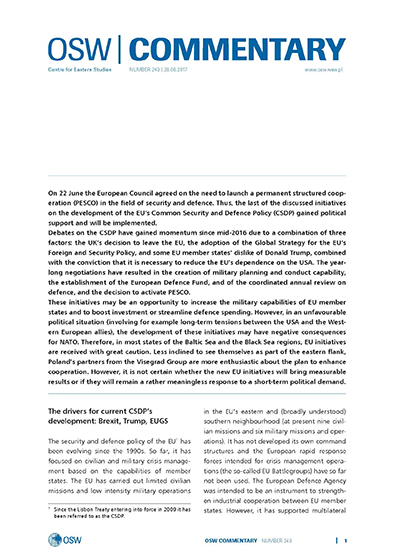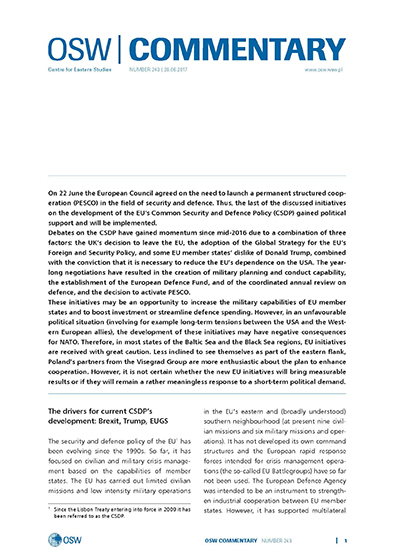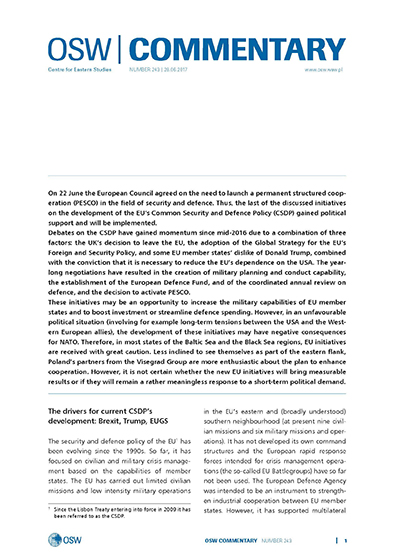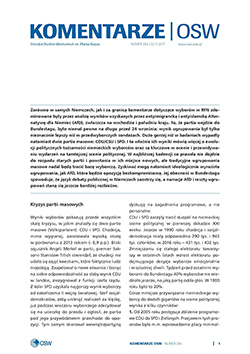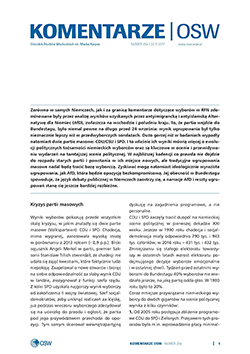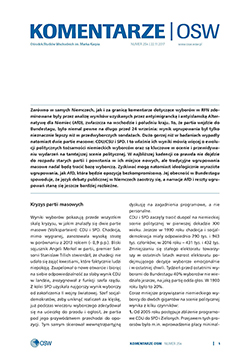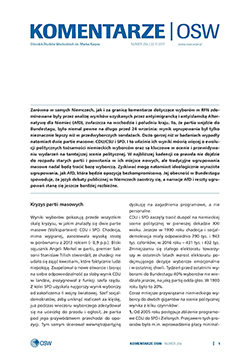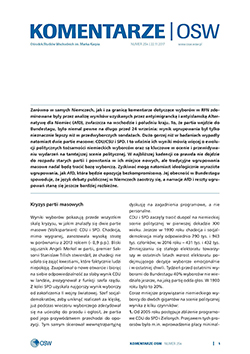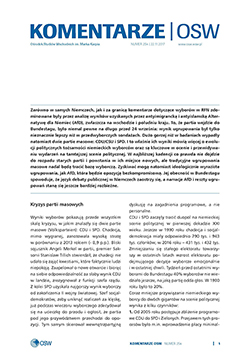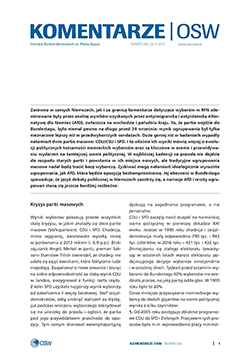Overstretched? Denmark’s security policy and armed forces in light of the new Defence Agreement
Author(s): Piotr Szymański / Language(s): English
Keywords: Denmark’s security policy; Defence Agreement;
In January 2018, Denmark adopted a new Defence Agreement for 2018–2023 – a cross-party strategy for the development of the Danish armed forces. The Agreement, which is adopted by the Danish parliament every five years and implemented regardless of the current governing coalition, provides, for the first time since 1989, for an increase in defence spending of 20 per cent, as well as a greater balance between out-of-area operations and collective defence. The Agreement also provides for the armed forces’ greater assistance to the police in anti-terrorism measures and border control, and investments in cyber capabilities. Despite these changes, the Danish armed forces will remain primarily an expeditionary structure. Moreover, the planned increase in defence spending could turn out to be insufficient to implement the Agreement in full. From minimalism to activismDuring the Cold War, Copenhagen’s defence policy was based on self-imposed restraints in NATO. Denmark refused to host allied bases and certain military exercises on its soil, and distanced itself from the US-Soviet arms race. The objective of not provoking Moscow into increasing military pressure on Scandinavia was achieved, among other things, by not consenting to the deployment of nuclear weapons and medium-range ballistic missiles in Denmark[1].Following the breakup of the Warsaw Pact and the ensuing enlargement of NATO to include Poland and the Baltic states, Denmark took a more active role in NATO and its alliance with the US[2]. It ceased being a country on the flank of the Alliance, and did not consider itself to be in danger of direct armed aggression. This enabled Copenhagen to concentrate its resources fully on participation in NATO crisis management operations and US-led coalitions in the Middle East – always having a broad mandate to use force and intense combat engagement[3]. At the same time, its armed forces got rid of armament and military equipment which was unsuited for asymmetric warfare, such as submarines and ground-based air defence systems.The aim of large-scale involvement in out-of-area operations was to enhance Denmark’s standing in the international arena and make its armed forces an important foreign policy asset in relations with its key allies, mainly the US, followed by UK and France. The US is not only a key supplier of armament and military equipment for the Danish armed forces; cooperation with the US is of prime importance to Denmark because Copenhagen sees Washington as a guarantor of freedom of the seas and trade. Safe shipping routes are of fundamental importance to Denmark’s economy due to the operations of the Danish company A.P. Møller-Mærsk, the largest freight shipping company in the world (it has a fleet of 590 ships, and accounts for 15% of total global container trade[4]). The turning point in 2014In 2014 the end of the ISAF operation in Afghanistan, which heavily engaged the Danish armed forces for more than a decade, coincided with Russia’s annexation of Crimea. The latter led NATO to focus more on collective defence and deterrence against Russia, particularly in the Baltic Sea region. This new security situation forced Denmark to adjust its defence policy to the changes taking place in NATO. This took the form of Danish engagement in US and subsequently NATO’s reassurance of the Baltic states. Immediately after the annexation of Crimea, Danish F-16s bolstered the policing of Lithuanian, Latvian, and Estonian airspace (BAP), while land forces played a more intensive part in allied exercises in those countries[5]. Denmark also contributed to the land component of the NATO–VJTF (1000 troops under UK command in 2017) and to the enhanced forward presence of allied troops in the Baltics (from 2018, 200 troops in Estonia in the UK-led battalion-size battlegroup).From 2014, Danish military intelligence reports revealed growing challenges from Russia to security in the region. Even though Denmark does not consider a Russian attack on a NATO member state to be a realistic scenario, it does believe that Russia might test the credibility and unity of the Alliance in the Baltic region by putting pressure on the Baltic states. From the Danish perspective the gravest threat to state’ security continues to be terrorism, although in recent years Copenhagen has also paid much attention to illegal immigration and cyber attacks.Measures to strike a balance between a larger military commitment in the Baltic Sea region and providing a significant contribution to remote deployments (since 2014 principally in Syria, Iraq, and Mali), as well as pressure from the US on its European allies to address the issue of low defence budgets, have revived the debate in Denmark on insufficient defence spending and personnel shortages in the armed forces. Some politicians and members of the military have stressed that the level of defence spending and the armed forces’ capabilities are not aligned with Denmark’s’ aspirations regarding its role as a reliable ally to the US and an active member of NATO[6]. In 2017, there were approximately 15,000 professional soldiers and 4200 conscripts in Denmark’s armed forces. The New Defence Agreement – a belated response?The most important subjects discussed during the negotiation of the new Defence Agreement for 2018–2023 were the scale of the increase in defence spending, the need to adapt the expeditionary model of the armed forces to the requirements of collective defence, whether it was reasonable to increase the number of conscripts, and the part played by armed forces in ensuring domestic security. The final wording of the new Agreement published in January 2018 was a consensus reached by six out of the nine parties in the Danish parliament[7]. This represents a compromise between the position taken by the centre-left opposition and the governing liberals, who are in favour of keeping the current model of the armed forces in place, and the suggestions made by the political right. These concern more balance between expeditionary capabilities and engagement in the Baltic region, as well as investments in domestic security[8]. Of the new initiatives provided for in the document, most funds have been allocated to developing a capability to deploy a heavy brigade outside Denmark’s borders, the armed forces’ assistance to the police, and defence against cyber attacks.(1) Increased defence spending. The Agreement provides for a gradual increase in defence spending, which is to rise by 20% of 2017 levels by 2023. However, experts estimate that this spending will only amount to around 1.3% of GDP, which means that Denmark does not intend to honour the Wales 2014 NATO summit commitment for NATO members to increase spending to 2% of GDP by 2024. Nevertheless, in recognition of NATO’s requirements, Copenhagen is planning to allocate a minimum of 20% of its defence budget to purchasing new armament and military equipment. In 2017, Denmark allocated 1.17% of GDP to defence, which is US$4,158 billion (including 12.10% on new military procurements).(2) Collective defence. The Agreement takes into consideration recommendations made by NATO defence ministers in June 2017 regarding the development of the members’ defence capabilities. Denmark was asked to increase its readiness to participate in collective defence in the Baltic Sea region[9]. To achieve this, from 2024 Copenhagen intends to have the capability to deploy a heavy brigade against a more equal opponent under a NATO collective defence framework, in particular in the Baltic states. This brigade will be equipped with tanks, ground-based air defence, anti-tank weapons and artillery, possessing its own command support, logistics and reconnaissance. It will consume approximately one-third of the extra funds provided for in the Defence Agreement. However, the creation of a new brigade within the army structure will not mean an additional 4000 troops in the armed forces; the brigade is to be formed on the basis of “army’s current operational capabilities” (Denmark has two brigades). In practice, the brigade will be partly composed of mobilisation units and reservists (readiness for deployment within 180 days). Moreover, the brigade’s subunits will be able to participate in out-of-area operations. It is therefore debatable whether the brigade will be ready for a prompt response within the collective defence effort.(3) Armament and military equipment. The priorities in the technical modernisation of Denmark’s armed forces until 2023 will involve strengthening the areas most neglected after the end of the Cold War, namely air defence and anti-submarine warfare. The investments in air defence include procurement of 27 F-35 fighter jets, which is regulated under a separate cross-party agreement from 2016[10], and the deferred purchase of SM-2 surface-to-air missiles for the Iver Huitfeldt frigates[11]; this most likely means that Copenhagen wishes to increase its navy’s interoperability with the US Navy (for example in escorting aircraft carriers). Developing the anti-submarine capabilities of the Danish navy will include the purchase of sonars and anti-torpedo systems for vessels, as well as dipping sonars and torpedoes for Seahawk helicopters. Closer cooperation with other countries on anti-submarine warfare is also envisaged.(4) Conscription and mobilisation capabilities. Although Denmark has been developing its expeditionary armed forces for almost three decades, it has retained limited conscription (at the moment 98% of conscripts volunteer). The aim was not to maintain a trained reserve to be mobilised in the event of a conflict because the system of total defence was dismantled in Denmark after the end of the Cold War. The basic, four-month training period was intended above all to encourage conscripts to join as professionals. The new Defence Agreement increases the number of conscripts by 500 (from 4200 to 4700 annually) and extends training for some of them from 4 to 8 months. This decision was imposed mainly by the nationalist Danish People’s Party. The Danish armed forces did not favour the plans for an increased intake of conscripts, fearing new costs and duties for the professional component. The expansion of conscription in 2018–2023 is intended to broaden the recruitment base for regular troops (Denmark is struggling with a manning deficit, especially in the navy) and to help restore the armed forces’ mobilisation potential. Denmark plans to be able to mobilise 20,000 troops – both reservists and Home Guard members)[12].(5) International missions. Foreign deployments remain a priority for the armed forces. The Agreement provides for an increase in funds of 50% for this purpose (participation in NATO’s battalion-sized battlegroup on eastern flank will also be funded using this money). In addition, Denmark will set up a joint deployable Special Operations HQ with Belgium and the Netherlands.(6) Domestic security. The 2015 migrant crisis, during which a record number of asylum-seekers entered Denmark, and the higher terrorism threat (due to Danish citizens joining ISIS, among other factors), have led Denmark to increase the assistance which the armed forces give to the police in order to ensure domestic security. Under the Agreement, among other things, a light infantry battalion will be formed (500 troops) ready to assist with anti-terrorism operations, and the armed forces will still participate in border control. The Danish police, which has border guard powers, is struggling with a lack of personnel, as it is overstretched due to its new duties connected with the migrant crisis and the risk of terrorism.(7) Cyber security. Cyber security is becoming more important in Denmark as the country becomes more digitalised. The wake-up call for Denmark was an attack by hackers on the defence ministry in 2015–16, and a computer virus which paralysed A.P. Møller-Mærsk in 2017, causing estimated losses of US$300 million. Denmark holds Russia responsible for both of these attacks[13]. Therefore, Denmark will invest 1.4 billion kroner in cyber security by 2023. This will allow, among other things, the creation of a 24-hour national cyber situational centre to monitor cyber security threats[14].(8) The Arctic. The Arctic is of vital importance for Denmark. Copenhagen has retained control over autonomous Greenland, making Denmark a member of the Arctic Council. It enhances Denmark’s international standing, and brings the prospect of extracting Arctic natural resources[15]. The Arctic is also an important area of cooperation with the US because of the latter’s military presence in Greenland (the Thule radar station)[16]. The Defence Agreement provides for the greater activity of armed forces in the Arctic (including patrolling and search & rescue operations). The Agreement also guarantees funds for eliminating environmental contamination in former US military installations in Greenland. Denmark is worried that this matter could inflame anti-Danish feeling and benefit an independence movement. However, the Arctic is low on the list of the defence ministry’s financial priorities. This is due to Denmark’s unwillingness to militarise the Arctic (Denmark is aware that it has insufficient potential to take part in an Arctic arms race), as well as the fact that until now the Arctic has been an area of cooperation based on international law. Question marksWhile the new Defence Agreement provides for the greater involvement of the armed forces in providing domestic security and greater mobilisation capabilities, the Danish army will remain primarily an expeditionary structure until 2023. There will be no fundamental change to the model for the armed forces, and the objective of the new strategy is above all to achieve greater flexibility for the army when responding to various kinds of threat. After more than two decades of focusing on crisis management operations and asymmetric warfare, it will take time to develop a capability to fight in conventional conflict under a collective defence framework.It could prove difficult for Denmark to put these ambitious plans for 2018–2023 into practice for financial reasons. While the Defence Agreement provides for a reversal of the downward trend in defence spending, at the same time there are only plans for a return to the level of spending that existed prior to 2013. Also, the largest share of the planned rise in defence spending has been put off until 2022–2023, and so, despite the armed forces’ urgent needs, the defence budget will continue to stagnate in the coming years. The Ukraine crisis and pressure from the Trump administration have not led the Danish political parties to take measures to gradually increase the defence budget to the target of 2% of GDP. This is mainly because social spending and the welfare state are always priority issues in Danish elections. The fact that there is no perceived threat in Denmark of direct armed aggression is also a factor; according to opinion polls, only one in three Danes believes that Russia poses a threat to their country[17].Denmark will probably continue to try to compensate for the low defence spending in the form of major expeditionary involvement in NATO and US-led operations. However, this policy might be limited in its success due to a current lack of operations on the scale of ISAF. Also, while NATO was focused on out-of-area operations, Denmark’s low defence spending went unnoticed due to the defence budgets of a number of allied countries being lower than Denmark’s in GDP percentage terms. However, the return to the deterrence against Russia since 2014 has led to a gradual rise in the European NATO members’ defence spending; according to forecasts, by 2024 more than half of the allied countries could have reached 2% of GDP[18]. This will make it difficult for Denmark to sustain the image of a sound NATO member, as in the period up until 2023 it only intends to raise its defence budget by 0.1 percentage points (to 1.3% of GDP).In the coming years Denmark wishes to intensify the activity of its armed forces domestically, regionally, and globally – from the Arctic, through NATO’s eastern flank, to the Middle East. In view of the moderate increase in defence spending (and personnel shortages), it could turn out to be impossible to reconcile such activity in so many areas. Especially as the most expensive modernisation programme in the history of Denmark’s armed forces – the purchase of F-35 fighter jets – will be an enormous burden on Denmark’s defence budget in the period to 2026[19]. [1] The self-limiting membership of Denmark and Norway in NATO, together with Sweden’s and Finland’s policy of neutrality were elements of the so-called Nordic balance.[2] The Ellemann-Jensen doctrine (Denmark’s foreign minister 1982–1993). See G. Szelągowska, Dania, Warsaw 2010, pp. 321–322.[3] After the end of the Cold War, Denmark took part in all NATO’s out-of-area operations (in the Balkans, Afghanistan, the Horn of Africa and Libya). It also contributed to US-led coalitions in the three Iraq wars (1990–1991, 2003–2011 and since 2014). M. R. Olesen, J. R. Nordby, The Middle Eastern Decade: Denmark and Military Interventions in H. Edström, D. Gyllensporre, Alike or Different: Scandinavian Approaches to Military Interventions, Santérus Academic Press Sweden, 2014, pp. 62–102; H. L. Saxi, Norwegian and Danish defence policy: a comparative study of the post-Cold War era, Norwegian Institute for Defence Studies, Defence and Security Studies 1/2010, pp. 29–60.[4] R. Milne, Maersk CEO Soren Skou on surviving a cyber attack, Financial Times, 12 August 2017, https://www.ft.com/content/785711bc-7c1b-11e7-9108-edda0bcbc928[5] Denmark responded favourably to the need for greater military engagement in the Baltic states. The tradition of active support for the independence of Lithuania, Latvia and Estonia from the 1990s still continues in Denmark. The Danish contribution to reassurance the Baltic states in 2014–2015 was one of the largest in NATO. In the Saber Strike 2014 exercises in Lithuania, a Danish mechanised battalion took part (with a tank unit). Danish company-sized units also participated in month-long exercises in Lithuania (2014 and 2015) and in Latvia (2015).[6] To give an example, due to a shortage of technical personnel and the level of wear of its F-16 fighters, Denmark was forced to temporarily halt the participation of its air force in the fight against ISIS (2015). Budget shortages also led to a delay of several years in the purchase of military equipment (self-propelled howitzers, armoured personnel carriers, SM2 missiles).[7] The Danish Ministry of Defence, Agreement for Danish Defence 2018–2023, 28 January 2018, http://www.fmn.dk/eng/allabout/Pages/danish-defence-agreement.aspx[8] The nationalist Danish People’s Party criticised the armed forces for being better prepared for battle in the Middle East than for defending Danish territory.[9] Ch. Hyldal, Claus Hjort: Dansk Nato-brigade skal hjælpe med at afskrække russerne, Danmarks Radio, 29 June 2017, https://www.dr.dk/nyheder/indland/claus-hjort-dansk-nato-brigade-skal-hjaelpe-med-afskraekke-russerne[10]The programme cost is DKK20 bn (approximately US$4 bn). Aftale om anskaffelse af nye kampfly, 9 June 2016, http://www.fmn.dk/nyheder/Documents/aftale-vedr-kampflyanskaffelse-2016.pdf[11] The navy will also begin preparations to acquire SM-6 missiles. Also, Denmark is examining the purchase of long-range precision guided missiles (potential procurement in 2023–2026, no information was given as to the missile launching platform or the type of missile). Besides, Denmark maintains readiness to be part of NATO’s Ballistic Missile Defence.[12] Following mobilisation in the event of a conflict in the Baltic Sea region, they would mostly be involved in providing Host Nation Support.[13] C. Hjort (Denmark’s defence minister), ‘Rusland stod bag cyberangreb mod Mærsk’, KrigerenDK, 15 February 2018, http://krigeren.dk/claus-hjort-rusland-stod-bag-cyberangreb-maersk/[14] Denmark will also join the NATO Cyber Defence Centre of Excellence in Tallinn and the Helsinki-based European Centre of Excellence for Countering Hybrid Threats.[15] The Act on Greenland Self-Government from 2009 extended island’s autonomy, acknowledging the people of Greenland as a separate nation with a right to self-determination. Under the Act, Greenland can obtain independence by means of economic emancipation from Denmark (two-thirds of Greenland’s budget still consists of subsidies from Denmark) and inter-government negotiations, followed by a referendum. Copenhagen remains responsible for Greenland’s foreign and security policy. See P. Uziębło, Podstawy ustroju Grenlandii (wybrane zagadnienia), Przegląd Prawa Konstytucyjnego, Nr 1(17)/2014, http://www.marszalek.com.pl/przegladprawakonstytucyjnego/ppk17/01.pdf[16] The US military presence on the island is sanctioned under the bilateral agreement with Denmark on the defence of Greenland from 1951.[17] M. Jensen, Russisk trussel bekymrer hver tredje – vores naboer tager det mere alvorligt, TV2, 14 January 2018, http://nyheder.tv2.dk/samfund/2018-01-14-russisk-trussel-bekymrer-hver-tredje-vores-naboer-tager-det-mere-alvorligt [18] J. Ringsmose, Militærforsker: Danmarks rolle som Nato-duks står for fald, Altinget, 18 March 2018, https://www.altinget.dk/eu/artikel/militaerforsker-danmarks-rolle-som-nato-duks-staar-for-fald#.Wqi6XzyC8II.facebook[19] The Danish media are reporting more and more frequently that the value of the contract was underestimated.PDF icon Full text in PDF 160.39 KB Overstretched? Denmark’s security policy and armed forces in light of the new Defence AgreementRELATED TO THE TOPICNATO summit in Brussels: the eastern flank between the USA and EuropeWith Russia right across the border. Finland’s security policy
More...
